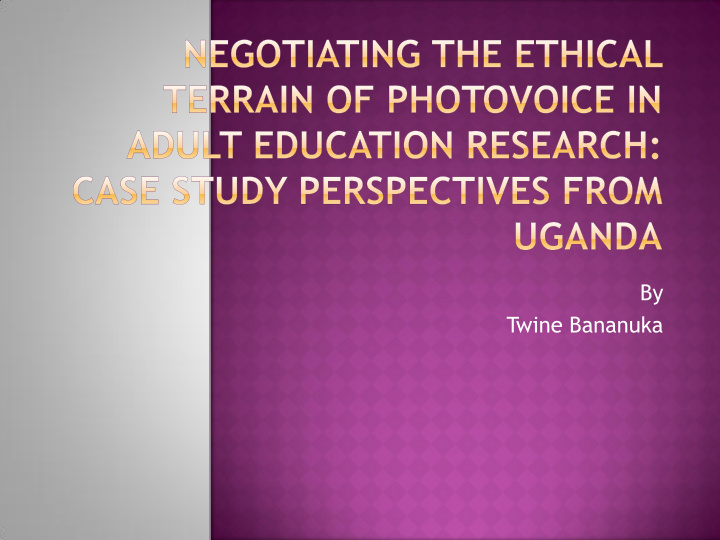



By Twine Bananuka
Although it is commonly held that ‘a picture speaks more than a thousand words’, It is equally true that a picture speaks more about the photographer than the person or image photographed (Silverman, 2005). Wade et al (2002) also note that ‘A picture is worth a thousand lies’
We have all at one point taken pictures or used them However, how often do we pause to ask; as to who took them, the purpose for which they were taken, the context in which they were taken and the intended audience. This gives a glimpse of the dilemma that researchers using photovoice and perhaps other visual methods find themselves in
It is a participatory technique that involves facilitating research participants to take and analyze pictures describing their world and practices Photovoice serves three major purposes, that is, enabling people to; Record and represent their everyday realities; 1) Promote critical dialogue and knowledge about 2) personal and community strengths and concerns; Reach policymakers 3)
The photovoice exploration reported in this paper was part of a larger case study of Emesco Development Foundation (EDF), an indigenous NGO focused on community development work. The study was conducted in Buyanja county, Kibaale district, in mid- western Uganda.
Photovoice was used with one group of the population, i.e. Community Development Workers (CDWs) as; a means of giving them an opportunity to tell their story and have their voices heard through photographic evidence It was also adopted because it aligns very well with the critical theory paradigm adopted for this study
Participant Sex Age Highest level Role in EDF Community pseudonym of education Teruth F 61 Primary 4 TBA Kiduukule Nsemba F 32 Primary 7 CHW Kiduukule Iruku M 30 Certificate CRP Kiduukule Balifaijo M 36 Senior 4 CRP Kiduukule Noreda F 52 Senior 2 CHW Busesa B Poskali M 68 Primary 7 CHW Lukindo
The issue of power relations and 1. vulnerability. Power relations Vulnerability and the right of minors/children. The hows and the process of publishing photographs The anonymity clause
2. The use of money to facilitate photovoice research 3. The use and handling of the camera 4. The control over ethical procedure by the Principal Researcher
Noreda (pseudonym); I first took this photo of a mother who had just delivered … however when her husband later arrived, she told him about the photograph. He also said ‘please take mine too with my baby’ . I then took his photograph carrying the baby.
IRUKU (pseudonym) … after getting his permission to take his photograph as he worked on his blacksmith job, he objected that I do not also take the picture of his house, well knowing the poor condition in which it was. However, I later asked somebody else to go and take the picture for me because I felt it would be an interesting case to the study … PI/Facilitator; But this is against our agreed position of not taking pictures without permission … . Laughter … (picture was not included in the selection and participants were told why)... and they concurred).
A TBA examining an expectant mother; Although the TBA was my research participant/co-researcher, she passed over her camera to her son to take her photograph in action
Does permission/consent from parents morally bind the children?
A community meeting chaired by a local leader on community service
A TBA standing in the background giving postnatal lessons to mother before immunizing the children
A young couple with a newly born baby with the assistance of A TBA/research participant
Unemployed young men gambling on the roadside in the morning, instead of engaging in productive work
Appeal to human conscience and reasoning The protection of human dignity Carefully interrogating research participants on the ethical procedures followed on each photograph presented to the group Constantly being in touch with participants throughout the process rather than waiting to carry out an audit at the end of the process Categorization of photographs in terms into levels of publication
The argument advanced in this paper is that it takes more than written rules and standards set by Ethical Boards & Committees to deal with issues related to ethics of photovoice research Human judgement and the desire to protect human dignity remains key to photovoice ethics, although this standard can be abused
1) Dr. Vaughn John, University of KwaZulu- Acknowledgements Natal, South Africa 2) Prof. Budd Hall, University of Victoria, Canada
Recommend
More recommend